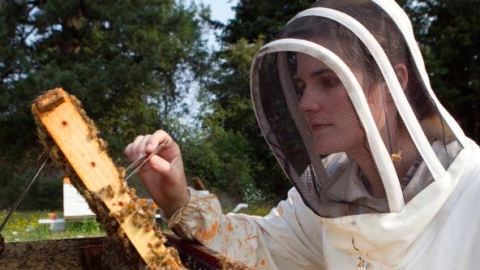To Solve Die-off Mystery, Scientists Put Digital Sensors on Honeybees

Honeybee populations are crashing for a number of reasons. Scientists have attributed the decline of the honeybees to a rise in the use of pesticides, disease, and loss of habitat. But there are factors still unaccounted for, leaving researchers concerned.
“We just don’t understand the combination of stressors that affect honeybees, and we don’t know why bee numbers are declining around the world. They might go through extinction; we just don’t know,” Commonwealth Scientific and Industrial Research Organization (CSIRO) Science Leader professor Paulo de Souza said in an interview with the BBC.

Researchers from Australia’s CSIRO have developed micro-sensors, weighing just 5.4 milligrams, and attached them to the backs of 10,000 healthy honeybees. The sensor will record each bee’s schedule: how far it flies from the colony, what kinds of pesticides it encounters, what it eats, and what other conditions it encounters. This data will allow researchers to get a better idea of the frequency in which colony collapse happens and its causes.
While investigations continue, countries have been working (in various efforts) to help the honeybees. Private companies in Norway’s capital, Oslo, have taken the initiative, working together to create a bee highway to help hives move across an otherwise barren cityscape. The United States Department of Agriculture last year stated that it would invest $8 million to expand honeybee habitats. A few million is just a drop in the bucket when compared to the labor costs the honeybees provide to us free of charge.
“Honeybee pollination alone adds more than $15 billion in value to agricultural crops each year in the United States,” the White House said.

We’re already starting to see what a world without honeybees would look like. Many countries, including the United States and China, have become desperate, having to resort to manual methods to induce pollination. A method I had the pleasure of learning just this summer. To “induce pollination,” you need to identify the male flowers, pluck them, and rub them up against the female flowers before they closed up. The zucchini flowers I grew in my garden would close up by 8am, allowing just a small window of time. Just imagine doing this with an entire field.
If the bees do fall into extinction, their absence will create quite a few job openings.
Read more at BBC.
Photo: Oregon State University bee researcher Ciera Wilson searches for ‘nurse bees’ in a hive outside on August 5, 2014 in Corvallis, Oregon. AAfter taking a sample, the researchers analyze the bee blood to determine the effects of pesticides do their the bee’s immune systems. The research could be useful in determining if why large number of bees have been dying recently. (Photo by Natalie Behring/Getty Images)





